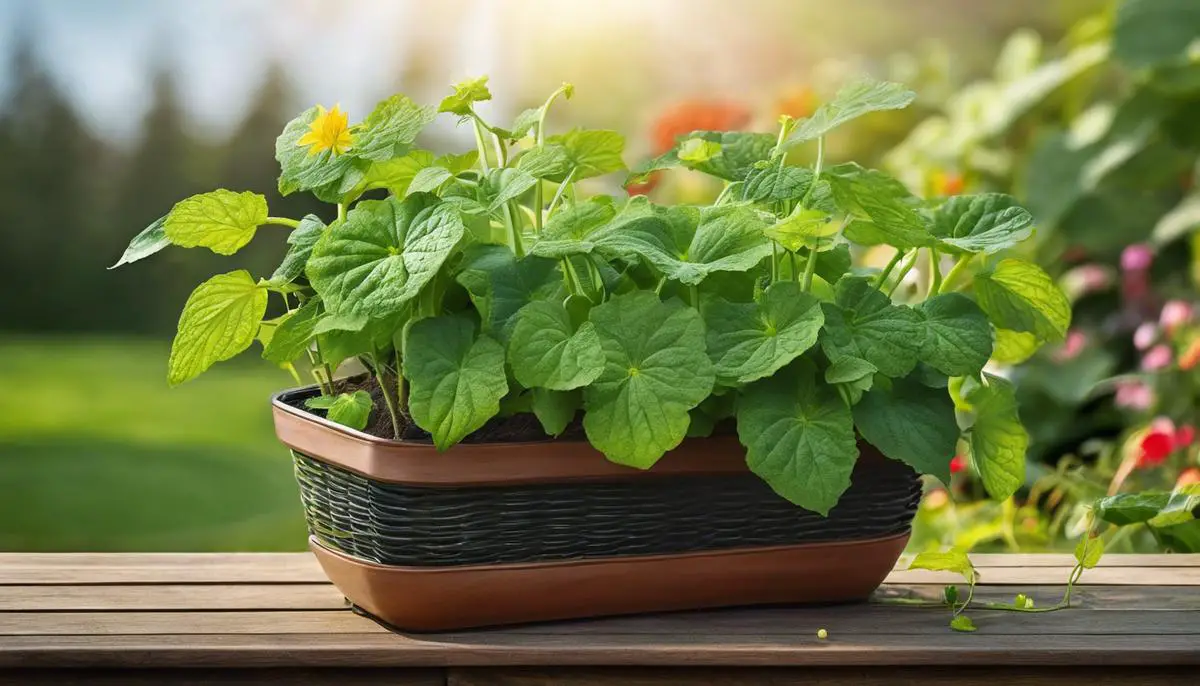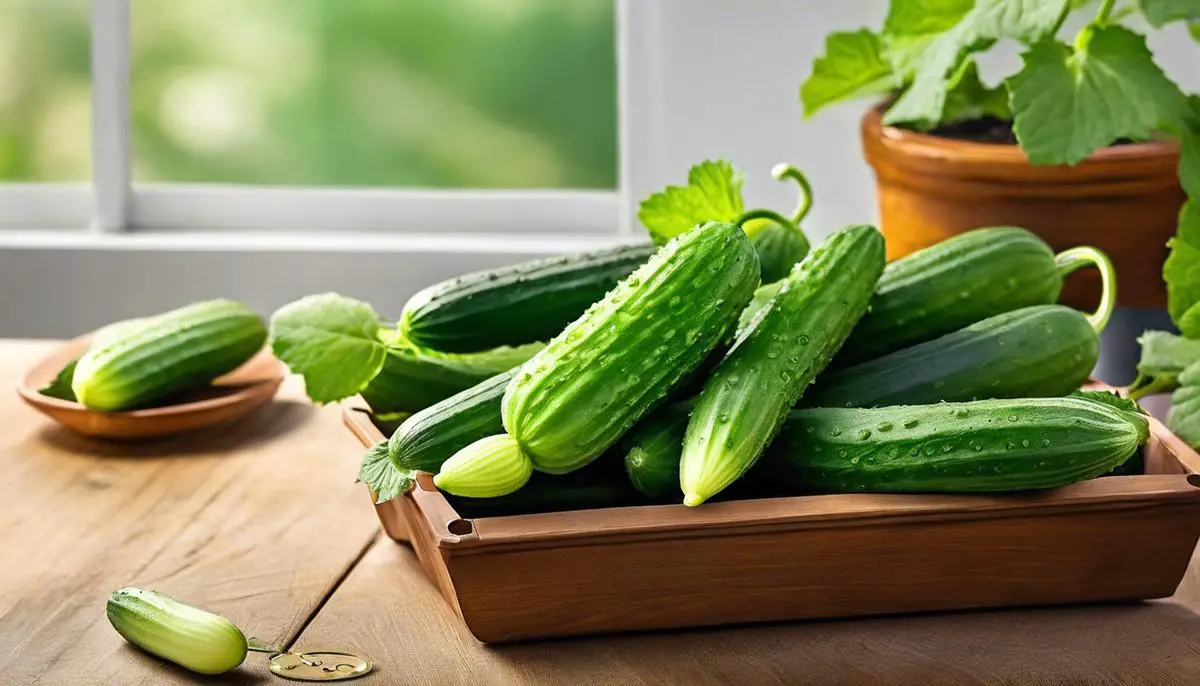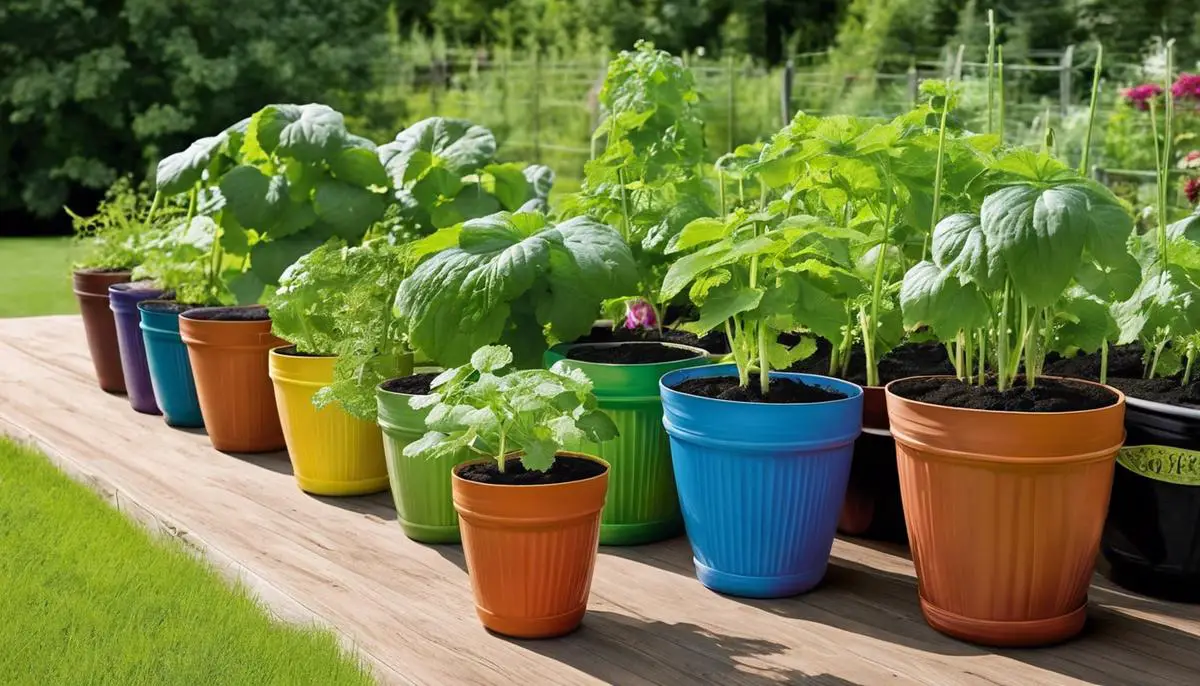Gardening offers a wealth of benefits, from stress relief to the production of fresh, healthy produce. Among the various fruits and vegetables that grace our plates, cucumbers hold a special place due to their versatility and nutritional boost. Cultivating cucumbers at home can be an achievable goal, even if you’re short on space. The concept of container gardening caters to this precisely as it hosts plant growth in a confined but sufficient area. This essay delves deep into the process of container cucumber gardening, encapsulating essential facets like choosing the right containers, practicing optimal planting techniques, and understanding cucumber care and maintenance.
Choosing the Right Containers
Finding the Perfect Containers for Your Cucumber Gardening Adventure!
Hello fellow gardening enthusiasts! As any seasoned green thumb could attest, hobbies can evolve over time. With throws of soil and seasons of planting, even amateurs can become well-versed in the art of spouting seedlings. Today, let’s dive deep into the world of cucumber gardening. Particularly, the best containers to ensure your cucumbers are thriving and bountiful.
Reader Poll: What online courses would interest you?
Cucumbers may seem like a plain salad staple to some, but to the gardening guru, they’re a delight to grow. Their vining nature offers visual appeal and the satisfaction of picking fresh, cool treats in hot summer months is unmatchable. Add to this the fact that cucumbers grow wonderfully well in containers, and it’s no wonder they’re a top pick for home gardeners! Now, choosing the right container can often feel daunting, but let’s break it down together.
Container Sizing Is Key
Remember, cucumbers love to spread their vines and need room to grow. When selecting a container, consider at minimum a 5-gallon pot. The more space your cucumber has to grow, the better. Container size and depth are crucial as cucumbers have deep root systems, and a bigger pot ensures adequate absorption of water and nutrients. A thumb rule to consider is one plant per 5-gallon pot.
Subscribe to our newsletter!
Material Matters: Clay vs. Plastic
Choice of material for your container is an important element to consider. Clay pots are aesthetically pleasing, provide natural moisture and temperature regulation that can be great for cucumbers. However, they are more susceptible to breakage and can be heavy to move.
Plastic pots, on the other hand, are lightweight, budget-friendly, and less fragile compared to clay pots. They might not provide the same level of insulation as clay, but they are a hard-wearing alternative.
Consider the Drainage: No Soggy Cucumbers
When selecting containers, pay keen attention to the drainage system. Cucumbers dislike “wet feet”. Pots should have ample holes at the bottom to prevent water stagnation, leading to root rot. Cucumbers prefer moist but well-drained soil.
Go Vertical with Containers
Cucumbers are vigorous climbers. Vining varieties will appreciate a little help climbing up! If your outdoor space allows, consider containers with built-in trellises, or add a sturdy cage into your pot. This utilitarian approach not only saves horizontal space but also facilitates air circulation, helping prevent fungal diseases.
Conclusion: Dare to Experiment
In essence, the choice of containers for budding cucumber plants is considerable – think outside the box and experiment with various options like fabric pots, barrels, or even repurposed containers. Remember, the hobbyist gardener isn’t afraid to get their hands a little dirty, and sometimes the sweetest successes sprout from unexpected soil! With these tips in mind, you’re set to embark on a joyful cucumber container gardening adventure. Happy planning, planting, and, ultimately, picking!

Photo by frankiefoto on Unsplash
Optimal Planting Techniques
The Enlivening Soil Mix for Cumbersome Cucumbers
As we delve deeper into the art of container cucumber gardening, let’s shift our focus towards the pivotal role that the right soil mix plays. Ensuring a well-aerated, nutrient-rich potting mix is the key catalyst for robust cucumber growth. Go for a blend of equal parts compost, peat moss or coconut coir, and perlite or vermiculite. The compost adds organic nutrients; the peat moss/coir maintains moisture, and the perlite/ vermiculite guarantees proper aeration and drainage.
The Essential Initial Planting Technique
Use seedlings, not seeds, when you start your container cucumber gardening. Why, you ask? Seedlings, acclaimed for their resilience, increase the chances of healthy plant growth. Ensure that each seedling is planted about an inch deep, making certain that the roots are fully covered with soil. For most standard-sized containers, two cucumber plants are optimal to prevent overcrowding.
The Stimulating Positioning and Sun Exposure
Positioning your cucumber plant is an underrated, yet critical narrating factor. Cucumbers love the sun- the more they’re exposed to it, the sweeter the cucumbers. A southern-facing spot ensures ample sunlight exposure. Aim for at least 6-8 hours of direct sunlight daily. However, in the hottest summer days, provide some afternoon shade to prevent overheating. Remember, always rotate the pot regularly to level out sun exposure.
On the Matter of Mulching
A beautiful spin-off benefit of mulch is its ability to reduce water evaporation, thus helping you stick to a balanced watering regime. Plus, mulch keeps those pesky insects and weeds at bay. Spread about 2-3 inches thick layer of mulch, preferably organic – straw or shredded bark on the soil surface.
The Regimen for Watering and Fertilizing
Guard against overwatering or underwatering your cucumber plant. Check the soil moisture regularly by sticking a finger an inch into the soil. If it feels dry, it’s time to water — aim for equal moisture levels not too wet, not too dry.
As far as fertilizing goes, cucumbers are heavy feeders. A water-soluble or liquid all-purpose vegetable fertilizer can work wonders. Administer it every two weeks following package directions but lessen the strength slightly- an ‘overfed’ plant can lead to fewer cucumbers.
That’s about it! With passion, patience, and these optimal cucumber gardening techniques at your disposal, there’s nothing stopping you from growing a flourishing cucumber plant. Happy Gardening!

Cucumber Care and Maintenance
Maintaining healthy cucumber plants in containers doesn’t stop at choosing the right pot and soil mix. Once your cucumbers are established, an ongoing regime of proper care will ensure a healthy harvest.
One of the key aspects in maintaining the health of cucumber plants is proper watering. Overwatering can lead to root rot while underwatering can cause your plants to wilt and yield less cucumbers. The key here is balance. As a rule of thumb, cucumber plants generally need about an inch of water a week – but this can vary depending on the weather and the specific type of cucumber you are growing. To check the soil moisture, push a finger into the soil up to your first knuckle. If the soil feels dry at that depth, it’s time to water. Water deeply until water begins to drain from the bottom of the pot, ensuring the roots are thoroughly hydrated.
In terms of feeding, cucumbers are heavy feeders and will benefit from regular fertilisation. Using a balanced vegetable fertilizer can provide the necessary nutrients for your plants. Follow the instructions on the label for the appropriate dosage and frequency, usually every 2-4 weeks. Be careful not to overfeed as this can lead to lots of foliage but fewer cucumbers.
Don’t forget about the importance of good sun exposure. Cucumbers love full sun, requiring at least six hours of direct sunlight daily. An ideal spot in your garden would be somewhere that gets morning sun. Morning sunlight is less intense and will help to avoid overheating, while also providing the cucumber plants enough light for photosynthesis. However, bear in mind that cucumber plants can get scorch in extreme heat, so be prepared to give them some shade during the hottest parts of the day.
Mulching is another useful practice in maintaining healthy cucumber plants. This can help to retain moisture and control weeds. Organic mulch such as straw or grass clippings are great choices. Layer about 2-3 inches of mulch around the base of your cucumbers, but be careful to keep it away from the plant stems to avoid rot.
Last but not least, remember that cucumber plants do not appreciate competition. Therefore, it’s essential to keep the plant base free from weeds. Not only do weeds compete for nutrients, they can also harbor pests and diseases.
Gardening can be an intimidating process at first. However, there’s something to say about the joy in watching a plant you nurtured flourish and produce a bounty of fresh cucumbers. Remember, patience and consistency is key, and with a little time and effort, your container garden will be filled with plenty of delicious cucumbers to enjoy. Happy gardening!

Gaining a thorough understanding of container cucumber gardening can help foster any aspiring gardener’s green thumb. Implementing these nuggets of knowledge can ensure that you cultivate cucumbers witnessing bountiful yields. Choosing an appropriate container initiates the journey, followed by the application of optimal planting methodologies. Yet, the learning doesn’t stop there, as cucumbers require consistent care and maintenance. From pinpointing the perfect sunlight exposure to catering to nutrient needs, the process is indeed intricate but fulfilling. With these insights, anyone can sow seeds of success in cucumber gardening, ultimately reaping crisp, refreshing cucumbers worthy of celebration.

